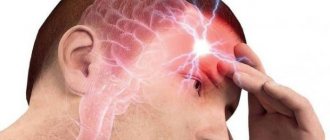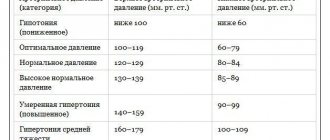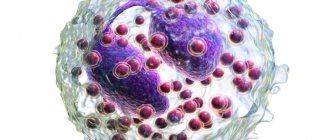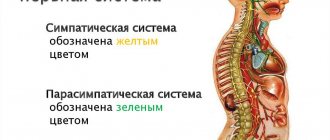Dementia is colloquially referred to as acquired dementia acquired during life rather than at birth.
It more often affects people of mature age and is associated with damage to the brain structure. The disease usually develops in one of two directions: atrophic or vascular. There are also mixed forms that combine both options.
Atrophic dementia is associated with the destruction of brain tissue and accounts for the largest percentage of cases. This includes the well-known Alzheimer's disease, as well as Pick's disease, Huntington's chorea, etc.
Vascular dementia develops against the background of “spoiled” cerebral circulation and accounts for approximately 15% of all dementors. It occurs with a variety of symptoms, which depends on the location of the pathological process, the area of the lesion and the caliber of the affected line.
Causes and essence of the disease
Vascular dementia develops due to disruption or cessation of blood circulation in one of the brain areas, as a result of which some brain cells die. The rate of progression of the process and the severity of symptoms will depend on how quickly the provoking factor acts.
Acute development of pathology is observed with stroke, ischemic or hemorrhagic. In the case of an ischemic stroke, a blood line is blocked by a thrombus. Its hemorrhagic form is characterized by rupture of the vessel. Both phenomena interfere with blood supply, which leads to irreversible death of cells in the brain area.
Typically, vascular dementia occurs in 25% of stroke patients. This happens if 50 ml of brain tissue is affected. The area and affected area play a big role. However, there are particularly sensitive areas of the brain, where even the slightest destruction entails disastrous consequences. These are, for example, the frontal lobes, visual hillocks.
For patients with vascular dementia, there is such a pattern: the first symptoms can appear either immediately after a stroke, or delayed, within six months. A period of 6 months is an indicative sign of vascular dementia. Typically, a stroke, especially a hemorrhagic one, leads to a rapid development of events, the appearance and increase of symptoms.
In a chronic destructive process, when small vessels are damaged, brain cell atrophy occurs gradually. Its compensatory mechanisms are activated, and symptoms increase gradually. The first signs are difficult to identify. Sometimes they hide not only from others, but also from the patient himself.
The main provoking factor that causes disruption of the patency and integrity of the blood network in the brain is atherosclerosis, that is, the deposition of sclerotic plaques on the vascular walls. Other reasons include:
- heart disease, cardiovascular failure;
- arterial hypertension;
- arterial hypotension;
- vasculitis – inflammation of the vessel wall;
- diabetes;
- hyperlipidemia;
- lack of estrogen;
- bad habits;
- excess body weight.
Treatment
For a pathology such as dementia after a stroke, treatment is prescribed immediately with an individual selection of medications. Includes vascular, replacement and neurometabolic therapy, as well as secondary preventive measures to reduce the risk of recurrent stroke.
A prerequisite is lifestyle correction and treatment of diseases of the cardiovascular system:
- Personal selection of antihypertensive medications.
- Prescription of antiplatelet agents (Clopidogrel, Acetylsalicylic acid, Pentoxifylline).
- Anticoagulants (Warfarin).
- Correction of the lipid profile reduces the risk of atherosclerotic plaque formation: Lovastatin, Rosuvastatin.
- Vasoactive agents: Vasobral, Tanakan, Cinnarizine.
To reduce the risk of dementia, neurometabolic therapy using nootropics is indicated: Piracetam (Nootropil), Actovegin, Cerebrolysin. The drugs have low toxicity and high bioavailability to organs and tissues. Anticholinesterase drugs slow down destructive processes (Galantamine, Rivastigmine).
General groups of symptoms
The disease distinguishes two groups of disorders: cognitive and neurological.
Cognitive disorders come to the fore, that is, regression of cognitive and thinking functions.
At the initial stage of the disease, memory is primarily affected. At first these are subtle changes. A person forgets some events, individual names and dates, and cannot find the right word to express a thought. The process of assimilation of new knowledge worsens, and it becomes increasingly difficult for the patient to remember and analyze new information.
Gradually, amnestic symptoms increase. The person does not grasp the meaning of what was said, and it becomes more and more difficult to find words. Because of this, his speech becomes meager, his sentences are short and monosyllabic. If talkativeness manifests itself, then it is incoherent; letters in words can be rearranged, words can be replaced. The person himself does not understand the meaning of what he said. Speech impairment leads to difficulties with writing and reading.
Amnesia occurs in the following forms:
- progressive - the patient begins to forget what happened to him recently, and then earlier events;
- fixation – inability to perceive, analyze, store new material, current events. Consciousness in such patients is preserved; they remember well the events of the past, but cannot remember what they talked about with the person 5 minutes ago. Having bought milk, brought it home and put it in the refrigerator, a few minutes later they are going to the store again to buy it, since they have already forgotten that they purchased it;
- Paramnesia is false memories when the patient supplements reality with unreal events. For example, he may pass off as reality events read in a book or seen in a film, and believe that this actually happened to him. Or he simply fantasizes, passing off as reality what did not happen. It is possible that events may shift in time, that is, what happened many years ago is perceived by a person as having happened yesterday.
In addition to memory, other cognitive functions are affected in vascular dementia. Attention is scattered, it is impossible to fix it for a long time. Perception is disrupted. Thinking becomes inflexible. It is difficult to switch from one activity to another.
Often, as the process progresses, patients develop a symptom such as Korsakoff's syndrome, named after the doctor who first described it. It combines several symptoms. First of all, this is fixation amnesia. As already mentioned, the patient does not remember current events, but retains memory of the past. In this regard, he loses orientation in time and space. So-called amnestic disorientation develops.
There are also various variations of paramnesia: doubts about the occurrence of a particular event, their displacement in time, a mixture of fictional and true events.
Against this background, a person gets lost in an unfamiliar environment. He doesn't understand where he is. While in the hospital, he cannot find his bed, but in a familiar environment, at home, he finds his way around perfectly.
When an elderly relative ceases to be adequate...
If a loved one has senile dementia, what should relatives do, and how can they understand that this is a disease and not ordinary whims? Most often, dementia begins quite harmlessly. A person may complain to relatives and neighbors that they are not feeding him, they are watching him, they are trying to kidnap him, or they are letting some substances or gases into his room or apartment. This might seem funny if it weren't so sad. The disease progresses quite quickly, and over time, older people stop recognizing family members, accuse them of theft or violence, bring home garbage from the landfill, and literally fight with anyone who tries to throw it away. Some people think that dementia will not affect those who have been engaged in active mental activity all their lives. The disease does not choose, and even a doctor of science or an honored leader can be found in a garbage dump, enthusiastically digging through waste.
There is no need to think that the patient is doing this on purpose, just to mock and laugh at his loved ones. This disease destroys the brain, and the patient is not even aware of his actions. The person loses the ability to absorb or process information. He becomes very sensitive to criticism: any remark or attempt to explain something leads to protest and a new attack. How to deal with a person with dementia? Relatives will have to show maximum patience and attention, not contradict, or explain something gently and unpersistently. If the patient feels aggression, he will begin to perceive his family as enemies, and it will be very difficult to establish contact with him.
Neurological disorders
In the initial stage of the disease, neurological dysfunctions manifest themselves as general symptoms. Weakness and fatigue, absent-mindedness, and irritability appear. I am bothered by systematic headaches and sleep is disturbed. There is an unstable emotional background. Depressive states are possible. The person is unrestrained, hot-tempered, and embittered. Emotional incontinence usually manifests itself in violent crying or laughter, weakness.
Among other neurological indicators, cerebellar syndrome occurs, characterized by uncoordinated movements. It seems that the arms and legs are moving chaotically. Because of this, the gait changes: it becomes shaky, slack. The person appears to be drunk. Instability of the step provokes falls.
The disease causes accentuation of personality traits. For example, if previously a person was scrupulous and meticulous, then pathology turns him into a picky grumbler.
Pseudobulbar syndrome is expressed by a triad of signs:
- dysarthria - pronunciation disorder;
- dysphonia – loss of voice sonority;
- dysphagia – problems with swallowing.
There are cases of paralysis and paresis, but quite rarely. Muscle tone and reflexes are increased.
Quite often, malfunctions in the functioning of the pelvic organs occur, and epileptic seizures occur.
In general, dementia of vascular origin is characterized by narrowness and fixation of mental processes, loss of flexibility of thinking, fading of cognitive abilities, and a narrow range of interests.
Cases of vascular dementia
Scientists have established for certain that the Russian writer, imperial maid of honor Smirnova Alexandra Osipovna, whom A.S. once admired. Pushkin, suffered from vascular dementia.
From her youth, she was distinguished by her gloomy mood or its swings, insomnia. At the age of 40, she suddenly lost weight and became haggard. I didn’t want to see doctors. She was treated on her own: sermons, rituals. Her heredity was burdened with mental disorders.
At the age of 69, her condition worsened further. Her speech became incoherent, she rearranged syllables in words and distorted them. Memory suffered and behavior was disrupted. The mental state deteriorated sharply, reaching the level of mental disorder.
According to data collected from eyewitnesses, Alexandra Osipovna was diagnosed with “atherosclerotic dementia.”
Another famous writer, the author of Uncle Tom's Cabin, Harriet Beecher Stowe, was also diagnosed with vascular dementia. She devoted her entire life to caring for her large family, fighting poverty and disease. In the last years of her life, after the death of her husband, Harriet lived completely alone. She exhibited strange behavior. Sometimes she came to Twain’s house and wandered around the rooms there. She didn’t pay attention to anyone, she was aloof. After walking around a bit among the people, she returned home. Her mental abilities had completely deteriorated, she practically could not take care of herself. The patient's memory underwent special destructive changes.
Classification according to clinical picture
Types of dementia:
- partial;
- total.
Dysmnestic or partial dementia can be suspected by a progressive decline in memory and attention. A sick person with such a disorder retains the ability to make judgments; intellectual functions change little.
With total dementia, the ability to adequately assess what is happening and make consistent judgments is absent, as is a critical assessment of one’s own condition. There is a disorder of higher mental and cognitive functions.
Forms of vascular dementia
The brain provides us with conscious existence, being responsible for mental, emotional, and adaptive processes. Its substance is strictly structured. Each of its departments is responsible for its functions.
However, any part of the brain can undergo destructive changes, as a result of which a certain type of activity is disrupted. Based on this, several forms of the disease are distinguished, differing not only in location, but also in the caliber of the affected vessels.
Dysmnestic or lacunar dementia occurs against the background of destruction of small-diameter vessels. As a result, multiple infarct foci appear in the thickness of the white and gray matter. This is the most classic variant of the course of the disease, in which all pathological manifestations are not clearly expressed. There is a measured decrease in intellectual abilities, mild memory impairment, and slight slowness of psychomotor skills.
The multi-infarction form is accompanied by damage to vessels of medium diameter, and usually develops in non-acute pathological processes. Its manifestations are insignificant and go unnoticed for a long time even by the patient himself. Its course is gradual. The disorders first progress and then freeze at a certain stage until the next micro-stroke. Among the symptoms of this type of disease, cognitive impairment comes to the fore. Neurological and emotional disorders gradually develop.
Subcortical vascular dementia is a disease of small vessels, against which atrophy of white matter cells occurs with the formation of ischemic areas. Scientists see the reason for this process in the accumulation of amyloid in the walls of the arteries, followed by its inflammation. The clinical picture of the disease is somewhat atypical. It can occur as Alzheimer's disease or as isolated dementia.
Autoimmune vasculitis, such as systemic lupus erythematosus and panarteritis, cause another form of the disease - cerebral vasculitis. It is expressed by dementia and confusion. As a rule, it affects patients over 50.
Mixed dementia combines two forms: vascular and atrophic, that is, Alzheimer's type.
Therefore, in the picture of the disease one can observe symptoms of both vascular dementia and Alzheimer's disease, but the latter prevail over the former.
How to treat?
As mentioned above, it is impossible to completely cure dementia. However, in the early stages it can be controlled and not allowed to develop, so that the last years and even decades of the elderly person’s life can pass comfortably.
If dementia has not progressed to an advanced stage, treatment is carried out at home. For atrophic dementia, the doctor may prescribe medications:
- acetylcholinesterase inhibitors to eliminate the deficiency of neurotransmitter hormones;
- glutamate receptor inhibitors to neutralize glutamate, which damages nerve cells;
- antidepressants to eliminate feelings of depression and improve mood;
- antipsychotics for delusions and hallucinations.
For vascular dementia:
- antihypertensive medications for hypertension;
- corticosteroids for autoimmune and cerebral diseases;
- interferons and immunomodulators for multiple sclerosis;
- aspirin and other anticoagulants to thin the blood;
- herbal preparation ginkgo biloba to normalize vascular function;
- B vitamins to normalize blood flow to the brain;
- gliatilin and other antidepressants and nootropics.
All these drugs keep neurons in working condition and prevent the destruction of nerve connections. Since each of them can have side effects, only a doctor prescribes them.
However, drug intervention alone is not enough. It must be accompanied by other measures.
- Communication – first of all with friends and loved ones. Healthy, positive interaction with people who are always ready to support evokes positive emotions, improves mood, and increases the tone of the whole body.
- Physical exercise. Age and general health are taken into account. These could be, for example, exercises to train coordination and fine motor skills.
- Psychological trainings. Sessions with a professional psychologist can help as well as regular pleasant communication.
- Physiotherapeutic sessions. Electrical stimulation under the supervision of a specialist helps improve the condition of a problematic nervous system.
- Proper nutrition. Meat, fruits, vegetables, grains - everything should be in the right proportions. Your doctor or nutritionist will advise you on how to eat.
- Getting rid of bad habits. In order not to aggravate the situation, it is highly advisable to quit alcohol and smoking.
It is necessary to monitor the patient’s overall health - monitor blood pressure, check cholesterol and blood sugar levels.
Binswanger's disease
The pathology is named after its discoverer and is subcortical atherosclerotic encephalopathy. Develops as a result of damage to small cerebral vessels and is a fairly common form of dementia: about 1/3 of all dementors.
It has been established that arterial hypertension plays a major role in the development of pathology. It was observed in 80% of patients with this form. Most often, the disease starts after 50 years and begins suddenly. The first signs of it may be a transient disturbance of cerebral circulation, accompanied by sudden paralysis, which, however, also suddenly disappears. Other signs include small strokes and parkinsonism. A magnetic gait is observed when the legs seem to stick to the floor.
Emotional incontinence appears in the form of sudden laughter or crying, speech is impaired, and control over vital functions (for example, urination) is lost. Problems with memory and thinking appear already at the beginning of the disease.
The symptoms of the pathology are quite varied. After all, the process causes extensive damage to brain tissue with ischemia, destruction of nerve cell processes, and demyelination of nerve fibers. The process is accompanied by steady progression, although cases of persistent remission are possible.
Tendency to run away from home
Another common problem that loved ones of a person suffering from senile dementia often face is the tendency to wander and run away from home. It would seem that he has everything for a comfortable life: comfortable housing, care and attention from relatives, but the patient continues to run away, and his relatives are lost in search.
If a person has dementia, how can those around them live, and how can they cope with constant “surprises” on their part? First of all, you need to talk to your neighbors and sellers from nearby stores so that they immediately warn the relatives of an elderly person if they see him on the street alone. You need to give them phone numbers that you can call and tell them where the patient is.
The patient himself needs to put on a bracelet on his hand, which will also contain the contact information of his relatives. The ideal option is a smart watch or phone with the function of tracking the subscriber’s movement.
Diagnostics
First of all, the diagnosis of the disease is carried out on the basis of the clinical picture, or, more precisely, the presence of cognitive and neurological defects in it. They significantly poison the patient’s life and do not disappear even with clear consciousness.
Correctly identifying symptoms, and subsequently prescribing effective treatment, allows timely diagnosis. Thanks to visual research methods, it has become very simplified, and this makes it possible to recognize the pathology in a timely manner without delaying treatment.
Among these methods are prescribed:
- MRI, CT;
- angiography, which allows you to assess the condition of blood vessels;
- rheoencephalography, which determines blood filling of blood vessels;
- EEG, which records the bioelectric signals of brain cells;
- nuclear resonance imaging, visualizing white matter, etc.
Consultations with related specialists are required: neurologist, cardiologist, psychiatrist. Blood pressure is systematically monitored.











